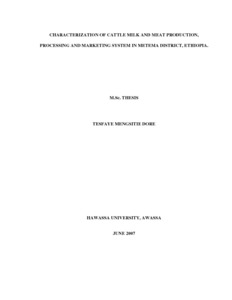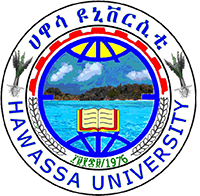Resource information
A study on characterization of cattle milk and meat production, processing and marketing system was conducted in Metema district based on data collected between September and October, 2006. A multistage sampling procedure was employed to select representative kebles and households from CBFS, SBFS and Gendawuha town. A total of 270 households were randomly selected using systematic random sampling method. Questionaire based formal survey as well as PRA techniques were employed to collect both quantitative and qualitative data on cattle milk and meat production and processing systems in the district, while RMA techniques were used to characterize the marketing system of dairy products, meat and live cattle. In addition, 30 households were voluntarily selected from the two rural farming systems and were continually monitored to collect quantitative data on milk and other dairy products produced per household. Accordingly, the latter data were used to corroborate the survey based information on related parameters. Two types of livestock production systems were identified in the district, namely crop-livestock mixed farming, which is exercised by resident farmers, and transhumance production system practiced by seasonally in fluxing farmers from neighboring highlands. The current study was concerned entirely on the former production system type. The average cattle herd size of households was 15.53 heads, but it varied significantly (P<0.05) among the three areas. Cows (30.45%) and calves (32.29%) mainly dominate the herd composition, while heifers (13.90%), oxen (12.02%) and bullocks (10.30%) represented minor proportions. Cattle type (Zebu) locally called Agew, Simada and Fogera were dominantly found in the district, although some cattle types introduced from neighboring countries known as “Ruthana” and “Felata” cattle were observed in minor proportions. Where as introduced temperate breeds were entirely lacking in the district. The breeding system was entirely natural mating. 65.8% of the interviewed farmers practiced selective mating, while the rest one-third left their cows for open mating with no concern for selecting the best bull, although some variation exist from area to area. Major feed resources used by the households were natural grazing (31.0%), crop residues (29.5%), crop aftermath (21.8%) and hay (17.8%). The available vast communal range lands provide high potential for conserving excess fodder during the wet season in the form of hay. Despite this, households make insignificant quantity of hay and face critical feed shortage during the dry season. Critical shortage of water was also noted during the dry season, particularly in highly arid lowlands. Three types of diseases were identified as the major health problem of cattle and these included tick infestation (37.2%), babesiosis (31.6%) and FMD (15.6%). Average milk off-take of indigenous cows was 1.9?0.045 liter/cow/day and on average cows gave a lactation yield of 324.0??10.274 liters/cow during an average lactation period of about 5.9?0.14 months. Cows in Gendawuha town gave significantly higher daily milk yield as well as were milked for longer lactation period than in the two rural areas. As a result, the lactation yield xix was significantly higher in the former than in the latter areas and these differences were mainly attributed to better feeding (supplementation) and management provided for the cows in the town. Overall, mean CI was 17.97?0.313 months, but it was significantly higher in the town than in the rural areas because of extended lactation. Mean AFC of cows in Metema was quite late (4.54?0.05 years) even by local standard. Out of the total milk produced, most of it was processed (63%), while some quantity was consumed with in the household (18%) and used for calf rearing (13%). On the other hand, most of the butter was consumed with in the household (58 %), while small proportion was sold out (25%). In general, the market share of whole milk and other milk derivatives (cottage cheese, butter milk and fermented milk) was almost negligible, while butter was comparatively the most marketable commodity in all the three areas. The dairy marketing system identified in the study area was entirely informal marketing system. Churning methods includes churning by placing the churner on the floor, hanging the churner on tripods and churner is shacked with both hands. Cattle fattening experience was not developed well, because of lack of experience (34.9%), shortage of labor (30.8%), feed shortage during dry season (17.5%) and shortage of capital (15.9%). Out of the total fresh meat produced, 49.8 % was consumed by the household in the form of fresh, while 50.2% was retained for processing. Milk and meat production and marketing system were constrained by theft of cattle, infectious and parasitic disease, lack of milk processing services, poor market information on the price and supply condition, lack of services (extension, inputs, and veterinary) and lack of feed processing and utilization management. Extension intervention should focus on dairy and meat production and processing as well as on improving the marketing system of these products.



